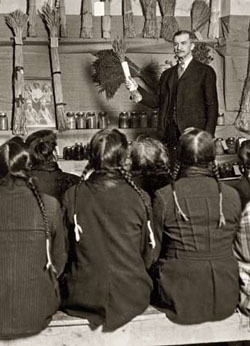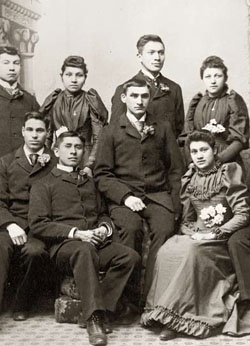Montana: Stories of the Land
Companion Website and Online Teacher's Guide
Chapter 11 - The Early Reservation Years, 1880-1920
Chapter 1 - Montana: Where the Land Writes History
Chapter 2 - People of the Dog Days
Chapter 3 - From Dog Days to Horse Warriors
Chapter 4 - Newcomers Explore the Region
Chapter 5 - Beaver, Bison, and Black Robes
Chapter 6 - Montana's Gold and Silver Boom
Chapter 7 - Two Worlds Collide
Chapter 8 - Livestock and the Open Range
Chapter 9 - Railroads Link Montana to the Nation
Chapter 10 - Politics and the Copper Kings
Chapter 11 - The Early Reservation Years
Chapter 12 - Logging in the "High Lonesome"
Chapter 13 - Homesteading This Dry Land
Chapter 14 - Towns Have Lives, Too
Chapter 15 - Progressive Montana
Chapter 16 - Montana and World War I
Chapter 17 - Montanans on the Move
Chapter 18 - The Great Depression Transforms Montana
Chapter 19 - World War II in Montana
Chapter 20 - Building a New Montana
Chapter 21 - A People's Constitution
Chapter 22 - Living in a New Montana
Educator Resources
Educational Trunks
-
To Learn A New Way from the Montana Historical Society. Created by Salish educator Julie Cajune, this trunk explores the reservation, allotment, and boarding school periods as experienced by Montana Indians.
Takeaways
-
Inspired by reading specialist Tammy Elser, who was in turn inspired by SKC graduate Taylor Crawford, we've created a "Takeaway" bookmark for every chapter of Montana: Stories of the Land. Before starting a chapter, print and cut out these bookmarks and distribute them to your students. Ask them to use the Takeaway to summarize the GIST of what they learn from reading assigned sections of the chapter. Remind them that they don't have much room, so they'll need to think before they write down the most important idea they want to take away from the section. Learn a little more about the GIST strategy.
-
Even though we've created Takeaways for every chapter, we don't recommend you have your students complete a Takeaway for every section of every chapter they read. That would be exceedingly tedious. However, used appropriately, they can be a useful tool for encouraging reflection and teaching students how to summarize information.
Websites and Online Lesson Plans
-
The Annotated Resource Set The Early Reservation Years, 1880-1920, includes links to photographs, maps, illustrations, and documents relating to early reservation history. Many, but not all, of the images were also used to illustrate Chapter 11 of Montana: Stories of the Land. These sources can be used to build PowerPoints or to create DBQs or other primary-source based activities.
-
Picturing the Past: Understanding Cultural Change and Continuity among Montana's Indians through Historic Photographs is a flexible two-day learning activity that challenges students to examine historical photographs while considering issues of cultural change and continuity over time.
-
OPI has model middle school and high school IEFA lesson plans on boarding schools.
-
Read this series of letters, digitized on the Montana History Portal, by and about the Spotted Eagle family in Heart Butte, Montana. One letter, from Matilda Spotted Eagle to Senator Thomas Walsh, tells about the arrest of her husband and mistreatment of her son who left boarding school against orders. A second letter, from Senator Walsh to the Commissioner of Indian Affairs, asks for an investigation. Letters from the Assistant Commissioner of Indian Affairs and the Blackfeet Agency Superintendent outline the government's official response.
-
A Beautiful Tradition: Ingenuity and Adaptation in a Century of Plateau Women's Art offers a classroom study unit based on women's beadwork and tied to Indian Education for All Essential Understandings.
-
The Internet Archives has digitized all of the Annual Reports of the Commissioner of Indian Affairs to the Secretary of the Interior from 1863 through 1938. Access these full-text, machine searchable documents here.
-
Exploring the Stories behind Native American Boarding Schools is a lesson plan from the Library of Congress that uses primary source material posted on the American Memory Project website. Native American Boarding Schools Primary Source Set provides additional resources and information.
-
OPI has a unit titled Playing for the World: The 1904 Fort Shaw Indian Boarding School Girls Basketball Team, designed to used with the PBS documentary Playing for the World. OPI donated a copy of the documentary to all public high school libraries. The video is also available online.
-
Stan Juneau's History and Foundation of American Indian Policy (2001) is a useful and accessible overview of the ways federal Indian policy has impacted Montana tribes.
-
The Indian Land Tenure Foundation has excellent information on allotment and its consequences, including a video. At the Indian Land Tenure Foundation you can also access lesson plans after registering for a free account.
-
Marquette University has digitized photographs and articles from The Indian Sentinel, 1902-1962, fundraising magazine published by the Bureau of Catholic Indian Missions that talked about the church's evangelization efforts (including boarding schools.) If you direct students to this material, you may wish to use it as an opportunity to have them analyze bias and intent (since this material was obviously created from a specific point of view to support a specific purpose.)
Videos or DVDs
-
Chapter 4, "Dislocation/Relocation" (17 minutes) and Chapter 2 "Homesteading" (17 minutes) of Montana Mosaic: 20th Century People and Events. (Site includes links to both User Guides with discussion questions and videos.)
-
Why Save a Language, Regional Learning Project - 27 minutes
-
Playing for the World, Montana PBS - 57 minutes
Possible Field Trips: View the Map
-
Chief Plenty Coups National Historic Landmark, Pryor. (Related IEFA lesson plans are available.)
-
Three Chief's Culture Center, Pablo
Chapter 11 Test and Answer Keys Page
The tests and answer keys are password protected.
You can contact us to receive the password:
- Martha Kohl - call (406) 444-4790 or email mkohl@mt.gov
- Melissa Hibbard - call (406) 444-4741 or email Melissa.Hibbard@mt.gov
Or, if you used the old system, the original username is now the new password. You will be asked for this case-sensitive password every time you open a new document.
Alignment to ELA Common Core Standards
Content Standards and Essential Understandings Regarding Montana Indians (EU)



